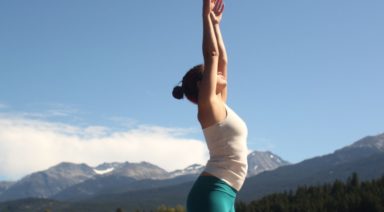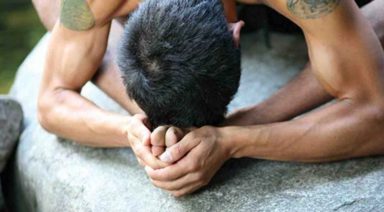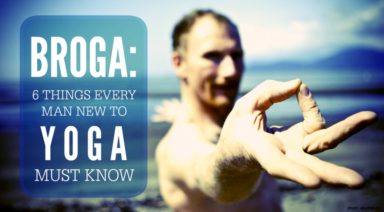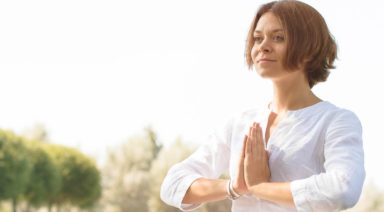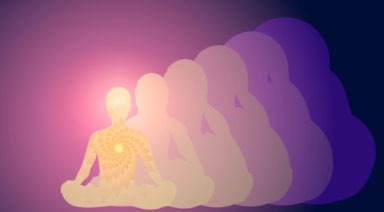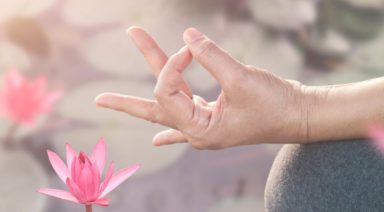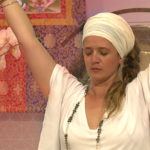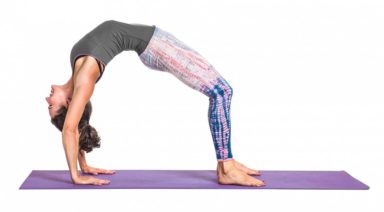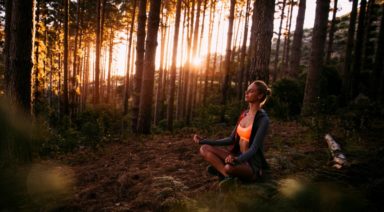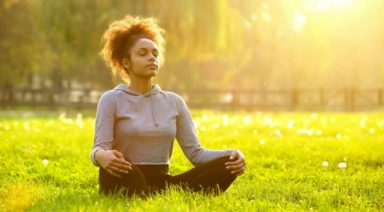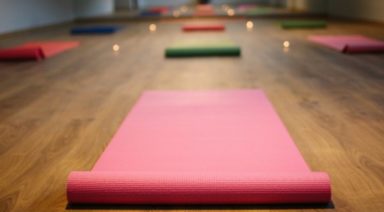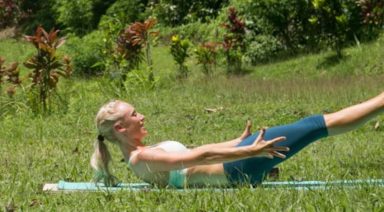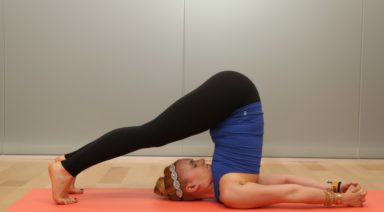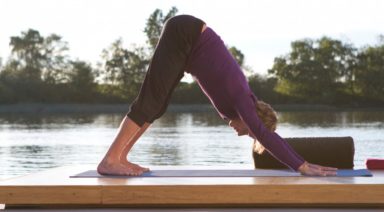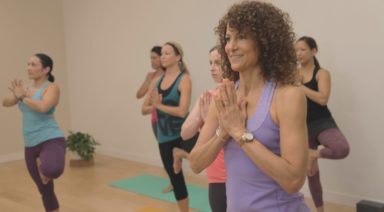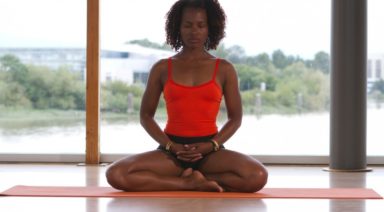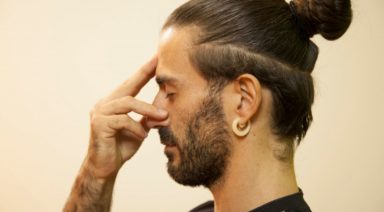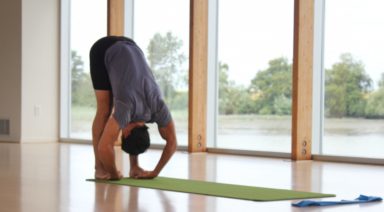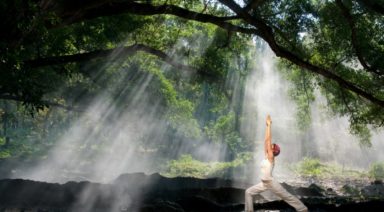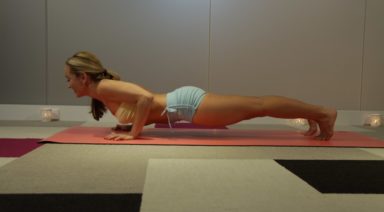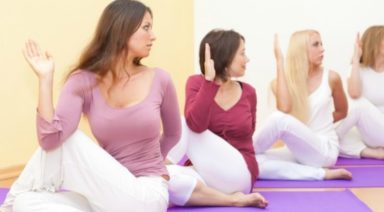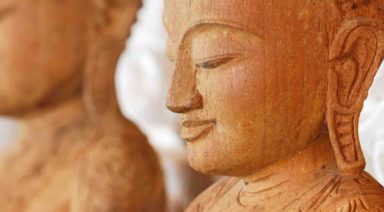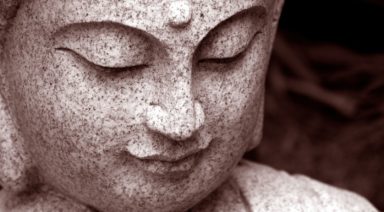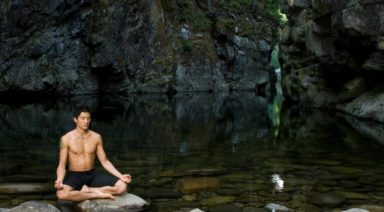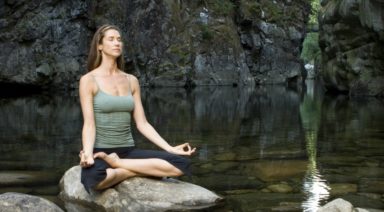What is Vinyasa Yoga?
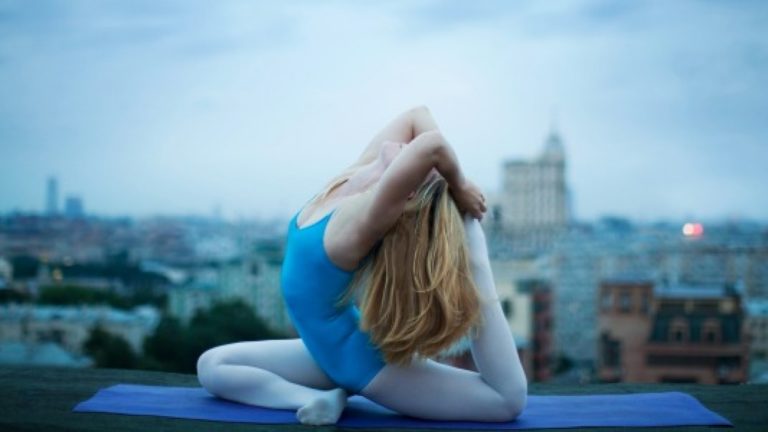
The first yoga class I ever took was listed on the schedule as “Vinyasa Flow.” Even then, with little to no understanding of what the word vinyasa meant, I remember feeling charmed by its sound. As I continued going to classes, I heard this term used in myriad ways and eventually came away with the lay understanding that vinyasa described a sequence of physical poses linked together with breath. It wasn’t until much later, during my first Yoga teacher training, that I became aware of the semantic interpretations of vinyasa. The following cursory introduction, akin to a page from the dictionary, still left much to be desired.
nyasa (v.) to place
vi (prefix) in a special way
vinyas (v.) to put down, deposit, place or lay on, fix in, turn or direct towards
vinyasa (n.) a series; an arrangement, a collection, an arrangement of distinct movements
As objective definitions, these words served me well as an entry point, but the potency of vinyasa did not begin to unfold until I found myself under the tutelage of Tantric devotee, Shiva Rea and Indo-philologist, Christopher Tompkins. Through their personal commitment to source texts, I have come to understand that vinyasa has but a single meaning:
vinyasa (n.) a series of actions performed with clear intention, in purposeful order, to illuminate conscious awareness
Like many Sanskrit sounds and words, any attempt to bring the term vinyasa to life using a foreign language is inevitably deficient; a purely etymological approach will always fall short, not because it is inaccurate, but because it lacks the inherent intimacy of the practice: the layered understanding of vinyasa is experiential and inextricably linked to the vibratory consciousness it describes. Vinyasa is a vehicle of Yoga, a practice of uniting mind, body and spirit through the art of attention and intelligent progression. Before we venture into the “how” and the “why” however, let us first consider the origins of Vinyasa Yoga that support this embodied practice.
Vinyasa Yoga: The Heart of Modern Postural Practice
The Tantric Origins of Vinyasa
Tantra refers to the body-positive spiritual lineage that recognizes universal divinity extant within the individual. Moreover, this divinity is expressed through complementary qualities of Shiva and Shakti, namely latent consciousness and creative flow. In Tantric philosophy, the realization of this absolute truth: that we are divine intelligence, can be attained through embodiment and direct experience, not merely through strict adherence to prescribed restraints and observances.
“Tantra teaches us that there is a unifying continuity between our physical bodies, the activities of our mind and emotions, and all forms of interior awareness.”
::Christopher Tompkins
When referring to a source text, the word tantra also calls to mind what Lorin Roche eloquently calls, “a tapestry of knowledge weaving together threads of yoga technique.” In his Radiance Sutras, Roche offers the more direct translation as well, “a manual of practices.” It is not clear when the earliest Tantras were written, although this lineage thrived between the 9^th^ and 12^th^ centuries. And from it, some believe, Vinyasa Yoga also emerged.
Mining for Wisdom
As a Sanskrit philologist and Tantric scholar, Christopher Tompkins has spent the better part of the last decade mining source texts for the wisdom of vinyasa and embodied practice; a pilgrimage requested of him by his father who experienced the transformational power of Yoga while battling cancer. Tompkins has methodically uncovered the roots of vinyasa imbued in the earliest Tantras and is now teaching them with poetic clarity for the edification of the global Yoga community. Tompkins has found, universally across an expansive corpus of source texts, a common, innovative sadhana (practice) that, despite changing shape from one lineage to the next, is life-affirming, not life-renouncing. He also describes in an interview with Sutra Journal, “the operative word in the Tantras for this sadhana is usually ‘sequence’ (vinyasa), wherein the ritual liturgy of ‘rites’ (kramas) are the yoga practices comprising it, which must be performed in a specific order.” Vinyasa is at the heart of the earliest postural Yoga practices.
Born of Source Texts
As co-creator of the ‘History of Yoga’ course, curated with Shiva Rea, Tompkins takes painstaking care to distinguish in his teaching between source texts and reference texts. In doing so, he explains that many of the canonical Hatha Yoga texts, such as the Hatha Yoga Pradipika, are in actuality, reference materials that draw upon earlier Tantric wisdom. Compiled during a time when the sacred feminine was experiencing the first hints of social renunciation, these popularized reference texts omitted or distorted the inherently fluid and feminine Tantric essence of vinyasa, leaving it buried in byzantine source texts which were far more intricate and less immediately accessible. As a result, Vinyasa Yoga appeared to materialize in the age of Krishnamacharya, around the 30’s and 40’s, seemingly unsubstantiated by ancient yogic tradition.
A Corrected Timeline: Closing the Gap between Ancient and Modern Practice
In the absence of a complete examination of innumerable Tantric verses, there have been recent claims suggesting the Vinyasa Yoga practiced by many Westerners was developed not roughly a thousand years ago with the advent of yogic tradition, but much later in the 20th century by Krishnamacharya, supposedly influenced by modern movement modalities like gymnastics. Tompkins rightly disputes this claim with new discoveries of postural sequences and rituals buried inside the early Vinyasa Yoga practiced today.
This is good news for modern Vinyasa Yoga practitioners because it validates our devotion to a “divinely transmitted” and thousand-year vetted practice. With his devout scholarship, Christopher Tompkins has essentially joined the first appearance of vinyasa in Tantric rituals from a thousand years ago to modern Yoga practice.
Vinyasa Yoga: Sacred Cycle and Intelligent Order
How You Do Anything is How You Do Everything
Empirical vinyasa is available to us at all times, from the mundane completion of household chores to the exquisite embrace of someone we love. Our lifetimes are a growing a collection of nows and the way we utilize each gifted moment inexorably shapes our reality. How we do anything is how we do everything, so why not do it in a special way? This is living vinyasa. A process of unifying the outer state with the inner state by completing any sequence of activities in such a way that we experience awareness and connection to source Self. The art of vinyasa is to unearth its potential in our everyday rhythm, be it breathing, speaking, working, eating or sleeping. Below are a few examples of disengaging the all too familiar autopilot and participating in the vinyasa of daily life:
- When you wake up, acknowledge the natural light you see and focus your gaze intentionally on something comforting, a photograph, a plant or someone sleeping beside you. Enjoy a long slow inhale and exhale before rising to a seat at the side of your bed. Cultivate gratitude by silently calling to mind something for which you are thankful. Placing both feet on the floor, feel the support of the ground as you stand. Whisper to yourself, “may I awaken to infinite potential.”
- In preparing a meal, try not to let your mind wander, feel the texture of your food and inhale the aromas. Contemplate the innovative and industrious beings that made this meal possible. Eat slowly while sitting down, avoiding the temptation to multitask. Instead, receive both physical and emotional sustenance by invoking the mantra, “may I be nourished,” throughout your meal.
Order Matters: The Sacred Arc of Vinyasa
“The idea of vinyasa, begin from where you are, go to a point, and come back to where you have to be.”
::-T.K.V. Desikachar
Vinyasa describes a sequential order of actions that progress according to the three rhythms in nature. That is, the organic arc of vinyasa proceeds from the beginning, through the middle and to the end. Consider, for example, the typical morning vinyasa of bathing and getting dressed. You wouldn’t put on your clothes before getting into the shower just like you wouldn’t towel off while the water was still running. The order is so implicit, we likely don’t even know it exists and yet, the order matters greatly.
Any sequence in life can evoke the qualities of vinyasa when we honor these cyclical rhythms. In the context of Vinyasa Yoga, both on and off the mat, these rhythms are:
- Shrishti (emanation): This is the igniting energy of beginnings and sets the foundation upon which to build any sequence of actions. Critical to initiating any vinyasa is the ability to observe and evaluate where we are at any given moment. Only then can we proceed in the way that best suits our needs, considering where we are starting from and the desired end result. Any time you feel yourself resisting a particular sequence of tasks, consider the mantra, “just begin.” After all, you can’t finish something you haven’t started.
- Sthiti (maintenance): After building momentum, this is the peak of any sequence, the fullest expression of actions. This phase of the cycle yields the sustaining energy that promotes growth and continuous expansion beyond the present cycle. When in this rhythm, I suggest using the mantra taught to me by Chuck Miller, “don’t stop, but don’t struggle.”
- Samhara (resorption): Completion is perhaps the most important rhythm in vinyasa and it is often the easiest to forget. In a culture of urgency, time scarcity and chronic hurry, we often neglect the skillful completion of tasks because we are too eager to move on. By honoring the completing energy of vinyasa, we retain what we need to support subsequent actions and dissolve any residue that might become a hindrance. Invite the mantra, “I surrender and start anew.”
Synchronize with Spanda
One of the most emotive definitions of vinyasa, and the one that resonates with me personally, comes from Shiva Rea’s “Tending the Heart Fire.”
“Vinyasa in its original meaning from early Tantras is understood as the “sequence of consciousness,” or how life unfolds from spanda: the creative pulse of life.”
::-Shiva Rea
Vinyasa requires a willingness to co-create with the universe within the parinama (continually transforming) nature of reality. It is the ultimate ability to “go with the flow,” without losing direction or aim. Vinyasa embodies the water-like quality of adapting to the path of least resistance, responding to obstacles rather than resisting them. In this way, Vinyasa Yoga is what Shiva Rea also describes as an “open system.” This will be covered in more detail in part II of this article, but in summary, it means vinyasa intuits order and action according to organic need.
Vinyasa Yoga: Life Practice
Just as Yoga is more than simply creating shapes with the body, vinyasa is much more than the order in which we place those shapes. From the instantaneous cycle of a single breath to the year-long circumnavigation of the Earth around the Sun, vinyasa permeates all rhythms of the universe, within and without. My hope in sharing this article is that we might first appreciate Vinyasa Yoga from a vantage point off the mat to bring greater awareness to the intrinsic intelligence available in physical practice.
Yin Yoga Benefits and History

Maybe you’ve heard of yin yoga but don’t really know what it is. Maybe you’ve tried it but lack some understanding of its origin or purpose. Or perhaps this is the first you’re hearing of it.
This exploration of the benefits and history of yin yoga will provide you some understanding of where yin came from and how it benefits people. If you find it compelling, get on your mat, keep learning more, and let us know how your journey unfolds.
To prepare for this article, I interviewed several Boston-based yin yoga teachers and regular practitioners. This is their scoop, filtered through some of my own experiences on what the benefits of this slow, meditative practice are.
What are the Benefits of Yin Yoga?
Seeing Within
When practicing this turtle-paced yoga style, unlike other varieties that are fast-moving and fancy looking, there is no wow-factor for spectators. Because yin yoga stretches connective tissue, especially at the joints, difficult inversions and impressive poses wouldn’t be safe considering how long they are to be held (anywhere from a couple of minutes up to around 20 minutes). To experience the wonders of yin, practitioners simply hold well-aligned, basic poses.
Doing poses in stillness promotes the cultivation of the inner life.
As yin yoga enthusiast Kourtney Hartmoyer has so eloquently put it, “the shapes are simple, perhaps even boring. To the outside world, it doesn’t look too interesting. However dull from an outside view, what I have found is that the quiet stillness of yin allows me to better observe the inner self a bit more clearly. It magnifies everything. That is where I find the magic.”
I have felt the magic, too. Yin yoga helps me to see myself on a deeper level through the cultivation of stillness. When I practice it’s not always easy or even possible to become physically still. Yet when I am able to “drop-in” and become motionless, the depth of awareness is simultaneously awe-inspiring and intrinsically peaceful. I can watch the inner play of my mind and subtle body as an observer. I can see within.
If you are planning to start a yin practice, it’s okay not to be absolutely still. It’s okay to struggle. The struggle contains information you can observe with kindness and curiosity. And when it finally subsides and you can be still, you can move deeper into yourself and into greater states of euphoric relaxation.
Moving Into Deeper States of Relaxation
Joanna Barrett told me that her daily yin practice helps her “to sit with sensation, moving toward or into deeper states of relaxation.” Moving quickly cannot promote deep trance-like states in the manner utter stillness can. If you’re curious, swap out the vinyasa flow for a yin vibe to appreciate what Joanna is talking about.
The depths of relaxation may require some preparation and commitment of time. It wouldn’t make sense for you to rush into a meditative state.
You’ll need time to allow your body to slowly drop into the depths of each pose. Completely support yourself with props, breathing deeply with lungs that move air like the bellows that feed fire.
Sure enough, the depth of sensation will tempt you to get out of the pose. I urge you to remain still while breathing deeper to experience the peace and meditation of true surrender. Can you stay just a little longer and relax just a little more? That might require a great deal of patience.





